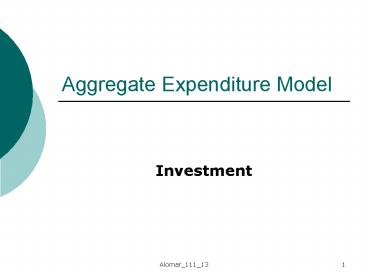Aggregate Expenditure Model - PowerPoint PPT Presentation
1 / 12
Title:
Aggregate Expenditure Model
Description:
Investment. Investment. Is the second component of private spending (beside C). Investment consists of expenditure on new plants, capital equipment, machinery, ... – PowerPoint PPT presentation
Number of Views:148
Avg rating:3.0/5.0
Title: Aggregate Expenditure Model
1
Aggregate Expenditure Model
- Investment
2
Investment
- Is the second component of private spending
(beside C). - Investment consists of expenditure on new plants,
capital equipment, machinery, inventories - Investment decision marginal benefit vs.
marginal cost
3
- If expected rate of return gt interest rate of
borrowing funds invest - If expected rate of return lt interest rate of
borrowing funds not to invest - Note that investors take their investment
decision based on the real interest rate - Rnominal rate rate of inflation
4
Deriving the investment demand curve
- What determine the amount of funds that investors
borrow? - Real interest rate (rr) an increase in rr will
increase the cost of borrowing funds, thereby
reducing the amount of I. - A decline in rr will reduce the cost of borrowing
funds, thereby increasing I.
5
Investment Demand Curve (ID)
- rr
-
ID
6
Determinants of I
- Changes in the level of rr will lead to a move in
ID curve. - This is the only factor leading to a move along
the ID curve. - All other factors will shift the ID curve.
7
Other determinants of I
- 1. Acquisition, maintenance, and operating costs
The initial and then the operating cost of
capital affect the expected rate of return in I. - 2. Business Taxes increase in taxes will reduce
expected profitability.
8
- 3. Technological changes stimulates investment
and lower production costs. - 4. Stock of capital goods as inventories rise,
expected rate of return on investment increase.
9
- 5. Expectations EX(r) depends on firms
expectations about sales, future operation costs,
future profitability
10
Investment and Real Outputs
- We now related the level of (I) to the level of
real outputs and income. - We will assume that we have planned I that is
independent of the level of DI and real outputs. - This is the case since I level is instable.
11
Equilibrium GDP
- Now we combine both C and I to explain the
equilibrium level of outputs, income, and
employment. - The following table shows this process
12
(No Transcript)

